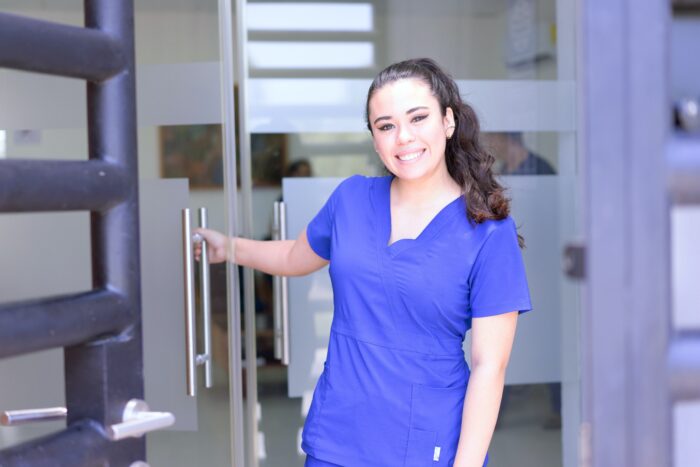If you’re looking to start a healthcare career, without spending thousands on tuition and years of medical school, you should consider a career in medical assistance.
Now, if this rewarding career has caught your attention, you might be wondering who medical assistants are, and what they do.
Medical Assistants are healthcare workers who assist physicians and nurses. Medical Assistants are primarily responsible for streamlining the workflow of a physician.
Typically, a medical assistant is responsible for both clinical and administrative tasks. In this guide, we go in-depth into the roles & duties of a medical assistant.
In this article, we will discuss in detail the duties and responsibilities carried out each day by medical assistants, and more.
So, let’s dive right in.
Also read: What is a Medical Assistant?
Clinical Medical Assistant Tasks
See: 12 Reasons to Become a Medical Assistant
Clinical medical assisting is your best choice if you are more inclined toward hands-on patient care. Certified Clinical Medical Assistants (CCMA) are majorly responsible for clinical tasks.
The key roles and responsibilities that a clinical medical assistant fulfills include the following:
- Administering vaccinations: The rising demand for vaccinations during the COVID-19 pandemic resulted in medical assistants nationwide being allowed to administer intramuscular injections after receiving proper training. This was not allowed before the pandemic in various states.
- Collecting Sample Specimens: A medical assistant can be tasked to collect urine and stool samples from patients. These samples are used for the analysis of any infections, problems with the liver or kidney, and internal bleeding.
- Checking and recording patients’ vital signs: Medical assistants are always required to keep a check and register changes in patient’s vital signs, as this is considered the first sign of illness. These vital signs typically include blood oxygen levels, heart rate, blood pressure, body temperature, and respiratory rates.
- Phlebotomy: Besides checking patients’ vital signs, blood reports help the physician analyze a patient’s health. Medical assistants are generally required to be skilled in phlebotomy, which typically involves performing venipuncture and drawing blood without causing any infections or injuries. After collecting the sample, the sample needs to be carefully stored & transferred for further diagnostics.
See: Can Medical Assistants Draw Blood?
- Removing Sutures: Although placing sutures is only allowed for doctors, physician assistants, and nurse practitioners, medical assistants can remove them. Further, they are also required to observe, note, and relay any infections or complications occurring at the site of sutures. (Medical Assistant vs Nurse)
- Prepping examination rooms: Most physicians’ offices and clinics are usually stocked with appointments daily, with very little time between each patient. Therefore, a medical assistant must ensure that the examination rooms are sanitized and cleaned before and after each patient visit. This avoids the spread of contagious pathogens.
- Maintaining and recording patient health histories: Before a patient sees the physician, a medical assistant must gather and maintain information about the patient. This record can include reasons for visiting, concerns, questions, and prior health histories. The medical assistant acts as a liaison between the patient and the physician. They also ensure that all the concerns shared by the patient have been reported to the physician.
- Maintaining and assisting with simple wound care: Even though a registered nurse or physician should handle serious wounds such as deep injuries or burns, medical assistants can help with simple bandages and covering small wounds. They can also further help with applying ointments and pain-relieving creams.
- Assisting physicians with bedside procedures: Medical Assistants can be further trained to assist doctors with in-office procedures such as steroid injections, skin biopsies, removing orthopedic screws and pins, inserting intrauterine devices, and so on.
- Assisting patients with their medications: Medical assistants, under the supervision of physicians, can help patients with their prescribed medicines, In some cases, medicines are prescribed & administered at the physician’s offices if they are not available at the local pharmacy.
Administrative Medical Assistant Tasks
If you’re drawn to administrative roles, a career as an administrative medical assistant is recommended. Administrative medical assistants usually have fewer clinical tasks, in addition to sometimes having the option of working remotely.
The key roles and responsibilities of an administrative medical assistant typically include the following –
- Scheduling appointments: Medical assistants act as liaisons between patients and physicians, so they have to assist patients in setting appointments with the physicians according to their schedules.
- Billing and insurance claims: Many patients require help with their billing and insurance claims. Medical Assistants have to assist such patients with the proper procedure to ensure smooth customer service and the smooth functioning of the healthcare facility.
- Data Entry: Medical assistants handle the entry of patient data, such as their contact information, appointments, and their reason for visiting the physician. This helps keep the healthcare facility organized and running smoothly, ultimately providing optimum patient care.
- Maintaining electronic medical records: Patient medical health records, such as their past medical histories and vital signs, need to be recorded and maintained electronically before each patient visit by medical assistants. This ensures all crucial information reaches the physician.
- Maintaining point-of-contact: Often, patients are hesitant or nervous while talking to a physician. Medical assistants assist patients with the same and carefully note down their concerns. Additionally, they are also required to maintain contact with the patients in case of rescheduling appointments, returning patients, and so on.
- Examination notes: Medical assistants are required to observe and record any abnormalities or take notes during physical examinations so physicians can review them later in case they happen to miss anything.
- Answering calls: Medical assistants are generally considered to be the face of the healthcare facility. They are required to answer any calls, including calls to schedule appointments, calls to answer patient queries or concerns, and calls from other representatives associated with the facility.
- Stocking of supplies: An organized and fully supplied stock room is essential for the smooth functioning of any healthcare facility. Medical assistants also have to ensure that necessary supplies are in stock, and in case of shortage; they are responsible for restocking.
Also see: Medical Assistant vs Medical Billing/Coding
Types of Healthcare Facilities That Hire Medical Assistants
As we stated earlier, the demand for medical assistants is set to rise rapidly.
But then you might think, “What type of facilities hire a medical assistant?” Or “Where Can Medical Assistants Work?”
There are various healthcare facilities and other industries that hire medical assistants, a few of which include:
- Assisted living facilities: Medical assistants are often required to work in assisted living facilities, wherein patients who are not independent receive care and support from medical assistants. Medical assistants working in such settings must complete additional training to be called medication technicians.
- Chiropractic offices: Chiropractic offices usually help people with back and spine problems, such as neck, joint, and back pain. They generally avoid medications and use physical therapy such as adjustments and massage. Medical assistants are often hired by chiropractors for administrative as well as clinical assistance around the office or clinic.
- OBGYN clinics: OBGYN stands for Obstetrics and Gynecology, and these clinics are focused on healthcare targeted toward women. The regular procedures here include providing care and support related to fertility, hormone therapy, pregnancy, birth control, etc. OBGYNs hire Medical Assistants to assist with different procedures.
- Pediatric clinics: Pediatric offices and clinics are focused on patient care involving children, infants, and adolescents. If you like being around children, you can pursue a career as a pediatric medical assistant.
- Family practice offices: These offices focus on providing preventative care and yearly checkups. Depending on the local, family clinics might get a high patient inflow. Multiple medical assistants might be employed in such a facility.
Medical Assistants are often confused with Nursing Assistants. Here’s everything you need to know about MA vs CNA.
Also see: Medical Assistant Scope of Practice by State
The #1 Thing Employers Want
According to the Industry Outlook Survey by the National Healthcareer Association (NHA), approximately 89% of employers encourage and require hiring medical assistants with certifications.
An overwhelming majority of employers prefer or even require Certified Medical Assistant. Institutions like the American Association of Medical Assistants (AAMA) or the National Healthcareer Association (NHA) hold exams, and you need to clear these certification exams to be certified.
Read: Medical Assistant Job Outlook
A certification is proof that you’re ready with the proper medical assistant skills.
According to BLS, a Certified Medical Assistant Salary is $37,190.
If you want to complete your medical assistance training, we have an ideal program for you that you should not miss checking out.
INTRODUCING- PREPPY’S ONLINE MEDICAL ASSISTANT TRAINING PROGRAM
Preppy offers an ideal training program for medical assistants that fulfills all the required criteria and even exceeds expectations.
Here’s how Preppy stands out:
#Accredited Courses:
Preppy’s Certified Medical Assistant Training Program is in partnership with a nationally recognized Accredited University, ensuring the program meets the gold standards.
#University Certificate:
Upon completion of the program, you receive a Certificate of Completion from the Accredited University, which adds credibility to your resume and impresses potential employers.
#Highly Affordable:
Preppy offers one of the most affordable medical assistant programs, allowing you to avoid student loans and financial aid burdens.
#100% Online & Self-Paced Classes:
Enjoy the flexibility of online classes that are accessible from anywhere and at any time, allowing you to learn at your own pace.
#Preparation for Certification Exams:
Preppy provides in-depth training that covers various aspects of medical assistance and prepares you for national certification exams, giving you an advantage in the job market.
#Fast Completion:
Complete your training in as little as 4 months, enabling you to become certified and start your career sooner.
#Externship Opportunities:
Gain practical experience through externship opportunities provided by Preppy, allowing you to apply your knowledge and skills in a real-world setting.
#Free Laptop:
Enroll in Preppy’s program and receive a free laptop that you can keep even after completing the program.
#24×7 Support:
Benefit from a dedicated Student Coordinator and 24×7 support, ensuring you have assistance whenever you need it, even on weekends or at odd hours.
With Preppy’s comprehensive and affordable program, you can receive quality training, gain valuable experience, and set yourself up for success as a medical assistant.

Do You Want To Become a Medical Assistant? Check Out Free Medical Assistant Masterclass!
In our masterclass you learn:
- How to be a medical assistant faster…in just 4 months!
- Avoid student debt & driving to classes
- #1 thing employers want from Medical Assistants
- How to stand-apart & get a university certificate for a strong resume
How To Become A Certified Medical Assistant
If you’re interested in this career, you’ve probably asked – “How to become a medical assistant?” As mentioned earlier, most employers want their medical assistants to be certified.
See: Is Medical Assistant a Good Career?
But how do you get certified? Do you need training in medical assisting? Let’s take a deeper look at all of that.
Step 1 – Obtain your high school diploma or a GED
Before sitting for your certification exams or enrolling in a program, you are required to complete your high school diploma or a GED.
Also read: Is Medical Assistant School Hard?
Step 2 – Complete the eligibility criteria for your Certification Exam
To be eligible to sit for your certification exam, you need to meet the eligibility criteria. There are two broad options for that –
Option 1: Completing your education program or medical assistant training.
You can complete your medical assistant training through an associate degree, a community college program, or an online certification program. After completing your exam, you have up to 5 years to appear for your certification exam.
See: Accelerated Medical Assistant Program
Option 2: Complete at least one year of supervised work in medical assistance.
If you already have at least a minimum of 1-year of experience as a supervised medical assistant, you can sit for the CCMA examination without obtaining a certification course or program.
This requires completing your experience as a supervised medical assistant within the past three years.
However, only some facilities hire untrained medical assistants. Sticking with option 1 and enrolling in a medical assistant training program is recommended.
Read more on- how long does it take to become a medical assistant here.
Choosing online medical assistant programs over a diploma or an associate degree is recommended. Here are a few reasons why:
Self-paced
While completing a degree or diploma course from an accredited university or college, the major disadvantage is that you have to keep up with the classes, assignments, and tests according to the pace set by the professors. Going for online programs offers you the freedom to learn at your own pace and get on-demand medical assistant training.
Learn Anytime, No Schedules
With an on-campus education, you must attend classes on a schedule and drive to campus multiple times a week. As busy adults, keeping up with a schedule can get challenging. If you miss a class, you must wait for months (or even a year) to attend the same class.
This is not the case with online programs. There are no schedules, and you can learn from the comfort of your home.
Also see: Medical Assistant Classes
Affordability
If you complete your education from an accredited college or technical university, the main advantage is that you get a university certificate.
However, the main disadvantage is that obtaining a degree from an accredited college costs anywhere from $8,000 to $30,000, which ultimately requires students to take on student debt.
Add to that the costs of traveling to and from the college and other lifestyle expenses.
If you opt for a legitimate online course or program, the costs will range from $1500 to $5000, which is far more affordable than enrolling in a full-time schedule.
Also see: Medical Assistant Programs Cost
Step 3 – Register yourself for the CCMA exam:
After completing your accredited training program, you will be required to register for the CCMA exam. You can do so from the NHA website. (Additional Resource – Which Medical Assistant Certification is the Best?
Step 4 – Schedule your exam:
CCMA exams are typically held at NHA-authorized and affiliated test centers. You will have the option of choosing the nearest test center to you for easy accessibility.
Step 5 – Prepare! Prepare! And Prepare!
You can easily find online resources such as practice papers, study guides, and other preparation materials online. Further, if you choose to opt for online training programs, you can easily revisit your program while preparing for your exam, which is not the case if you opt for a college degree or diploma.
Also see: Is Medical Assistant Degree Required?
Step 6 – Sit for your exam:
The CCMA exam lasts for 180 minutes. The exam generally includes 150 scored questions and 30 unscored questions. The CCMA exam typically covers subjects such as basic patient care, anatomy and physiology, infection control and confidentiality, healthcare ethics, as well as customer service questions.
Step 7 – Congratulations! You’re a Certified Medical Assistant
The CCMA exam typically only reveals the scores later; hence, you will have to wait for at least 48 hours after your test for your results.
If you do not clear this exam on your first attempt, you need to wait an additional 30 days to retake the exam.
Note – After a few years, you can also apply for the Administrative assistant exam by the NHA, and for that, you can have a look between CMAA vs CCMA
Step 8 – Apply for Jobs:
After you have cleared your CCMA exam and received your certification, you can now start applying for medical assistant jobs.
Also read: Medical Assistant Externship
Medical Assistant On-the-Job Training
Related Resources:
- Are Medical Assistant Licenses Required?
- How to get Medical Assistant jobs with no experience?
- Types of Medical Assistants
- Medical Assistant Educational Requirements
- Registered Medical Assistant
- Military Medical Assistant
- Medical Assistant Career Path
- Medical Assistant Job Description Plus Job Post Template
- National Certified Medical Assistant NCMA
- Medical Assistant Degree Online 6 Weeks
Related Articles
-
How to Be Successful in College in 2022 – 7 Simple Tips to Succeed
-
How Do Scholarships Work? Read This First…Truth is Shocking
-
7 Best College Majors 2024: What Should I Major In?
-
How to Choose a College – 10 Things You Must Consider in 2024
-
Why Go to College? Top 13 Benefits for Adult Students in 2022
-
Top 5 Best Alternatives to Community College for 2024









